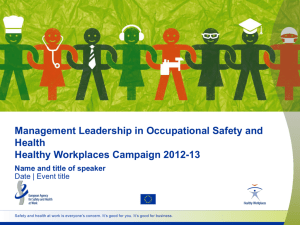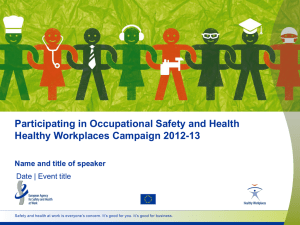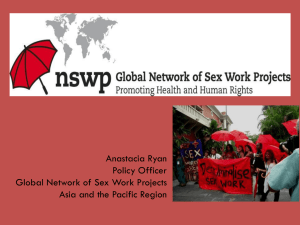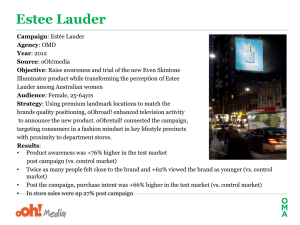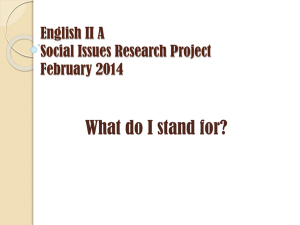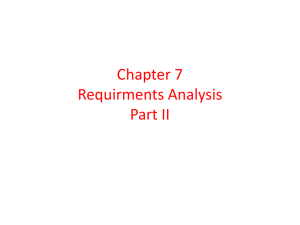Working Together for Risk Prevention
advertisement
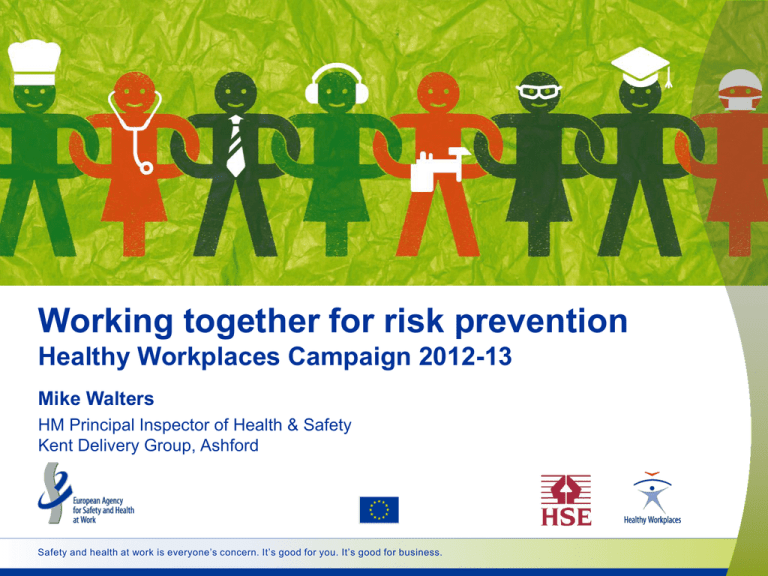
Working together for risk prevention Healthy Workplaces Campaign 2012-13 Mike Walters HM Principal Inspector of Health & Safety Kent Delivery Group, Ashford Safety and health at work is everyone’s concern. It’s good for you. It’s good for business. Scale of the problem Why is safety and health important? • Good for business, workers and for society as a whole • Significant improvements across the EU in recent decades, but … • Every year more than 5,500 people lose their lives due to workplace accidents • 159,000 die as a result of work-related illnesses (ILO estimates) • € 490 billion cost to the EU economy www.healthy-workplaces.eu 2 Benefits of good safety and health • Reduced risks and costs − Lower employee absence and turnover rates − Fewer accidents − Lower accident insurance costs • Productivity increases • Threat of legal action is lessened • Better reputation among customers, suppliers and investors www.healthy-workplaces.eu 3 Prevention is better than cure Prevention is the cornerstone of Europe’s approach to managing risks. Prevention is about managing work-related risks with the ultimate aim of eliminating and reducing the number of work-related accidents and occupational illnesses. www.healthy-workplaces.eu 4 What does prevention mean in practice? • Managers and workers working together to prevent risks • Managers and employers have primary responsibility • However….. active worker participation is vital for success www.healthy-workplaces.eu 5 Basic principles of risk prevention • Avoid risks • Evaluate risks that cannot be avoided • Combat them at source • Adapt work to the individual • Adapt to technical progress • Replace the dangerous by the non- or the less dangerous • Develop a coherent overall prevention policy • Prioritise collective protective measures over individual ones • Give appropriate instructions to workers www.healthy-workplaces.eu 6 Strategic aims of the campaign • Promotion of core message that workers and managers must work together • Giving clear guidance to employers to manage specific work-related risks • Provision of practical guidance to promote a risk prevention culture • Laying the foundations for a more sustainable risk prevention culture in Europe www.healthy-workplaces.eu 7 Management taking the lead It is the legal and moral duty of management to take the lead on workplace safety and health. In practice this means: • Visible and active commitment by management • Engaging with the workforce and their representatives • Effective ‘downward’ and ‘crossways’ communication • Using risk assessment to guide decisions • Integration of good health and safety management throughout an organisation • Promotion of these ideas throughout entire supply chain • Monitoring, reporting and reviewing health and safety performance www.healthy-workplaces.eu 8 Worker participation Worker participation is vital. Benefits include: • Lower accident rates • Cost-effective solutions • A happier and more productive workforce (lower absence rates) • Greater awareness and control of workplace risks www.healthy-workplaces.eu 9 Consulting on safety and health Employers have a duty to consult workers/worker representatives on health and safety. This means in practice: • Effective and open dialogue • Joint problem solving and decision making • Listening and acting on what is said • Participation in spotting hazards, assessing risks and devising solutions • Participation in implementing solutions and promoting safe working conditions • Workers fully cooperating with employers • Putting in place arrangements so these can happen in practice www.healthy-workplaces.eu 10 About the campaign How the 2012-13 Healthy Workplaces Campaign works • We help create safer and healthier workplaces for everyone’s benefit • But we cannot do this by ourselves • We need you to help foster and promote workplace safety and health www.healthy-workplaces.eu 11 Network-based campaigning Core strength: national focal points and tripartite networks. But also … engage other stakeholders/partners • Official campaign partners (Pan-European and international organisations) including social partners, NGOs, sectoral federations and networks, private companies • EU institutions including European Commission, EU Parliament, EU representations, EU agencies, Enterprise Europe Network www.healthy-workplaces.eu 12 How to get involved? The campaign is open to all individuals and organisations. You can get involved by: • Disseminating campaign information and materials • Joining in with one of the many events, conferences, competitions, advertising campaigns – taking place during the campaign • Organising your own activities www.healthy-workplaces.eu 13 Resources • Campaign guide • Practical guides for workers and managers • Good practice examples • News about campaign events • Presentations and animated video clips • All available in 24 languages www.healthy-workplaces.eu www.hse.gov.uk/campaigns/european/index.htm www.healthy-workplaces.eu 14 Key dates • Campaign launch: 18 April 2012 • European Weeks for Safety and Health at Work: October 2012 and 2013 • Good Practice Awards Ceremony: April 2013 • Healthy Workplaces Summit: November 2013 • Events in the UK: www.hse.gov.uk/campaigns/european/news-events.htm www.healthy-workplaces.eu 15 Further information • Visit the main campaign website www.healthy-workplaces.eu • To find out about events and activities in your country, contact your national focal point www.hse.gov.uk/campaigns/european/index.htm www.healthy-workplaces.eu 16 www.healthy-workplaces.eu 17

